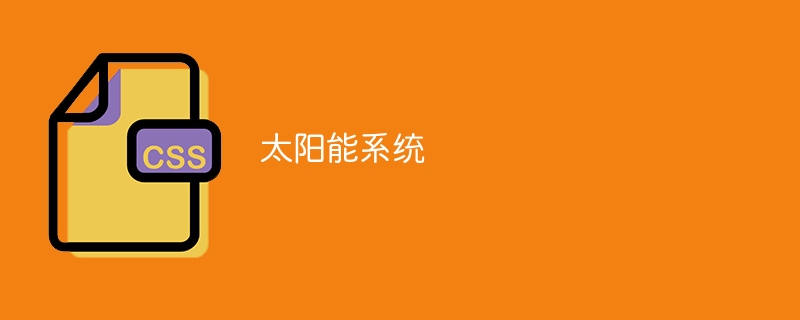太阳能系统
来源:dev.to
时间:2024-11-26 16:21:46 404浏览 收藏
偷偷努力,悄无声息地变强,然后惊艳所有人!哈哈,小伙伴们又来学习啦~今天我将给大家介绍《太阳能系统》,这篇文章主要会讲到等等知识点,不知道大家对其都有多少了解,下面我们就一起来看一吧!当然,非常希望大家能多多评论,给出合理的建议,我们一起学习,一起进步!

探索太阳系
欢迎来到我们的太阳系
探索太阳、行星、卫星以及其他一切让我们的太阳系变得非凡的奇迹。
<!-- Solar System Overview Section -->
<section class="solar-system-overview">
<h2>About Our Solar System</h2>
<p>Our solar system is home to the Sun, eight planets, dozens of moons, countless asteroids, comets, and other celestial objects. Located in the Milky Way galaxy, it's the only place we know of that harbors life – on Earth.</p>
</section>
<!-- Planets Section -->
<section class="planets">
<h2>Planets of the Solar System</h2>
<!-- Mercury -->
<article class="planet mercury">
<h3>Mercury</h3>
<p>Mercury is the closest planet to the Sun and the smallest in our solar system. It has no atmosphere, and its surface temperatures vary drastically between day and night.</p>
<ul>
<li>Distance from Sun: 57.9 million km</li>
<li>Orbital Period: 88 Earth days</li>
<li>Moons: None</li>
</ul>
</article>
<!-- Venus -->
<article class="planet venus">
<h3>Venus</h3>
<p>Venus is the second planet from the Sun and is known for its thick, toxic atmosphere. Its surface is hotter than any other planet in the solar system due to the greenhouse effect.</p>
<ul>
<li>Distance from Sun: 108.2 million km</li>
<li>Orbital Period: 225 Earth days</li>
<li>Moons: None</li>
</ul>
</article>
<!-- Earth -->
<article class="planet earth">
<h3>Earth</h3>
<p>Earth is the third planet from the Sun and the only planet known to support life. It has one natural satellite, the Moon.</p>
<ul>
<li>Distance from Sun: 149.6 million km</li>
<li>Orbital Period: 365.25 Earth days</li>
<li>Moons: 1 (The Moon)</li>
</ul>
</article>
<!-- Mars -->
<article class="planet mars">
<h3>Mars</h3>
<p>Mars, the fourth planet from the Sun, is often called the "Red Planet" because of its reddish appearance caused by iron oxide on its surface. It's a prime candidate for future human exploration.</p>
<ul>
<li>Distance from Sun: 227.9 million km</li>
<li>Orbital Period: 687 Earth days</li>
<li>Moons: 2 (Phobos, Deimos)</li>
</ul>
</article>
<!-- Jupiter -->
<article class="planet jupiter">
<h3>Jupiter</h3>
<p>Jupiter is the largest planet in our solar system. It's known for its massive size, Great Red Spot (a giant storm), and many moons, including the four largest: Io, Europa, Ganymede, and Callisto.</p>
<ul>
<li>Distance from Sun: 778.5 million km</li>
<li>Orbital Period: 12 Earth years</li>
<li>Moons: 79 (4 major: Io, Europa, Ganymede, Callisto)</li>
</ul>
</article>
<!-- Saturn -->
<article class="planet saturn">
<h3>Saturn</h3>
<p>Saturn is famous for its stunning ring system, which is made up of ice and rock. It's the second-largest planet in the solar system and has numerous moons, including Titan, its largest.</p>
<ul>
<li>Distance from Sun: 1.43 billion km</li>
<li>Orbital Period: 29 Earth years</li>
<li>Moons: 83 (Titan being the largest)</li>
</ul>
</article>
<!-- Uranus -->
<article class="planet uranus">
<h3>Uranus</h3>
<p>Uranus is unique for its sideways rotation and faint ring system. It's an ice giant with a frigid atmosphere composed mainly of hydrogen, helium, and methane.</p>
<ul>
<li>Distance from Sun: 2.87 billion km</li>
<li>Orbital Period: 84 Earth years</li>
<li>Moons: 27</li>
</ul>
</article>
<!-- Neptune -->
<article class="planet neptune">
<h3>Neptune</h3>
<p>Neptune, the furthest planet from the Sun, is a deep blue ice giant. Its most prominent feature is the Great Dark Spot, a storm system similar to Jupiter's Great Red Spot.</p>
<ul>
<li>Distance from Sun: 4.5 billion km</li>
<li>Orbital Period: 165 Earth years</li>
<li>Moons: 14 (Triton being the largest)</li>
</ul>
</article>
</section>
<!-- Moons Section -->
<section class="moons">
<h2>Fascinating Moons of the Solar System</h2>
<!-- Earth's Moon -->
<article class="moon earth-moon">
<h3>The Moon (Earth)</h3>
<p>The Moon is Earth's only natural satellite and the fifth-largest moon in the solar system. Its phases have been integral to human culture for millennia.</p>
</article>
<!-- Titan (Saturn) -->
<article class="moon titan">
<h3>Titan (Saturn)</h3>
<p>Titan is Saturn's largest moon and has a thick atmosphere and liquid methane lakes. It's one of the most Earth-like worlds in the solar system, despite its frigid temperatures.</p>
</article>
<!-- Europa (Jupiter) -->
<article class="moon europa">
<h3>Europa (Jupiter)</h3>
<p>Europa, one of Jupiter's Galilean moons, is covered in ice. Scientists believe there's a vast ocean beneath its frozen surface, making it a prime candidate for finding extraterrestrial life.</p>
</article>
</section>
<!-- Other Solar System Objects Section -->
<section class="solar-system-objects">
<h2>Other Celestial Objects</h2>
<!-- Asteroid Belt -->
<article class="asteroid-belt">
<h3>The Asteroid Belt</h3>
<p>The asteroid belt lies between Mars and Jupiter and contains thousands of rocky bodies. Ceres, the largest object here, is considered a dwarf planet.</p>
</article>
<!-- Comets -->
<article class="comets">
<h3>Comets</h3>
<p>Comets are icy bodies that originate from the outer solar system. When they approach the Sun, their ice turns to gas, forming a bright tail visible from Earth.</p>
</article>
<!-- Kuiper Belt -->
<article class="kuiper-belt">
<h3>The Kuiper Belt</h3>
<p>The Kuiper Belt is a region beyond Neptune filled with icy bodies and dwarf planets, including Pluto. It's similar to the asteroid belt but far larger and more distant.</p>
</article>
</section>
<!-- Footer Section -->
<footer class="footer">
<p>© 2024 Explore the Solar System. All rights reserved.</p>
</footer>
好了,本文到此结束,带大家了解了《太阳能系统》,希望本文对你有所帮助!关注golang学习网公众号,给大家分享更多文章知识!
声明:本文转载于:dev.to 如有侵犯,请联系study_golang@163.com删除
相关阅读
更多>
-
502 收藏
-
501 收藏
-
501 收藏
-
501 收藏
-
501 收藏
最新阅读
更多>
-
159 收藏
-
345 收藏
-
457 收藏
-
340 收藏
-
427 收藏
-
499 收藏
-
213 收藏
-
344 收藏
-
428 收藏
-
202 收藏
-
427 收藏
-
278 收藏
课程推荐
更多>
-

- 前端进阶之JavaScript设计模式
- 设计模式是开发人员在软件开发过程中面临一般问题时的解决方案,代表了最佳的实践。本课程的主打内容包括JS常见设计模式以及具体应用场景,打造一站式知识长龙服务,适合有JS基础的同学学习。
- 立即学习 543次学习
-

- GO语言核心编程课程
- 本课程采用真实案例,全面具体可落地,从理论到实践,一步一步将GO核心编程技术、编程思想、底层实现融会贯通,使学习者贴近时代脉搏,做IT互联网时代的弄潮儿。
- 立即学习 516次学习
-

- 简单聊聊mysql8与网络通信
- 如有问题加微信:Le-studyg;在课程中,我们将首先介绍MySQL8的新特性,包括性能优化、安全增强、新数据类型等,帮助学生快速熟悉MySQL8的最新功能。接着,我们将深入解析MySQL的网络通信机制,包括协议、连接管理、数据传输等,让
- 立即学习 500次学习
-

- JavaScript正则表达式基础与实战
- 在任何一门编程语言中,正则表达式,都是一项重要的知识,它提供了高效的字符串匹配与捕获机制,可以极大的简化程序设计。
- 立即学习 487次学习
-

- 从零制作响应式网站—Grid布局
- 本系列教程将展示从零制作一个假想的网络科技公司官网,分为导航,轮播,关于我们,成功案例,服务流程,团队介绍,数据部分,公司动态,底部信息等内容区块。网站整体采用CSSGrid布局,支持响应式,有流畅过渡和展现动画。
- 立即学习 485次学习
